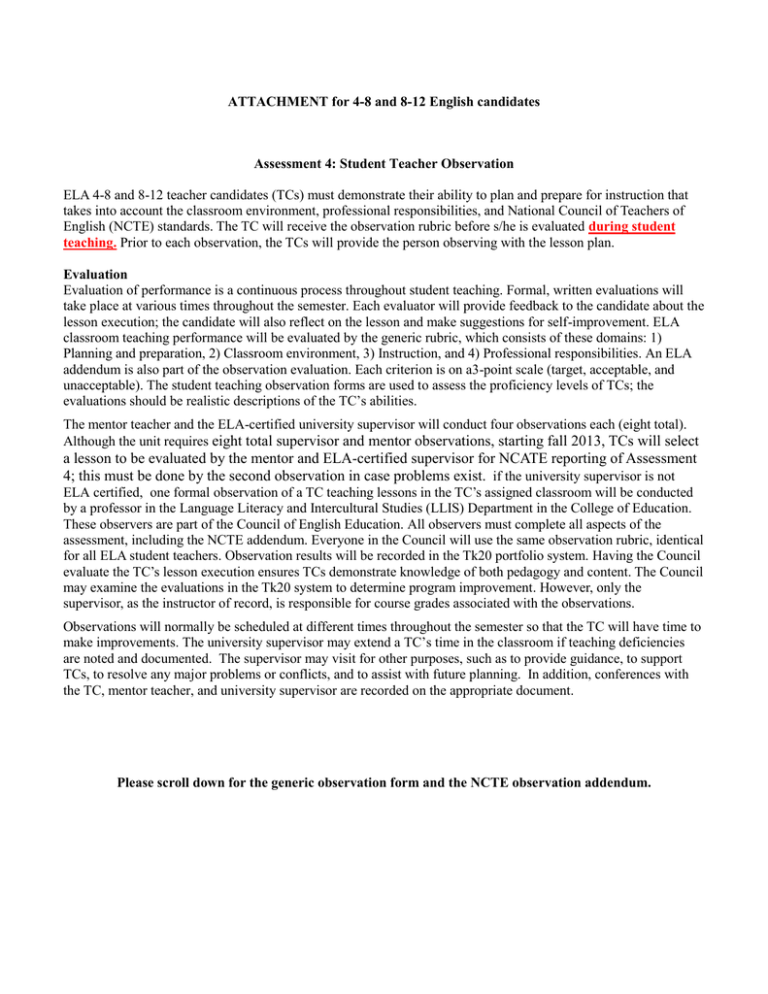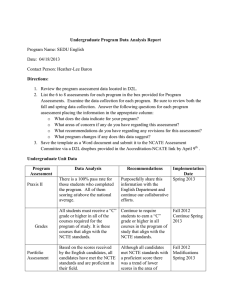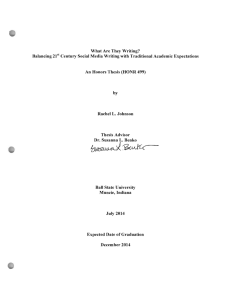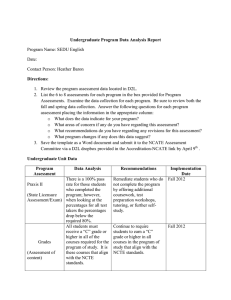ATTACHMENT for 4-8 and 8-12 English candidates
advertisement

ATTACHMENT for 4-8 and 8-12 English candidates Assessment 4: Student Teacher Observation ELA 4-8 and 8-12 teacher candidates (TCs) must demonstrate their ability to plan and prepare for instruction that takes into account the classroom environment, professional responsibilities, and National Council of Teachers of English (NCTE) standards. The TC will receive the observation rubric before s/he is evaluated during student teaching. Prior to each observation, the TCs will provide the person observing with the lesson plan. Evaluation Evaluation of performance is a continuous process throughout student teaching. Formal, written evaluations will take place at various times throughout the semester. Each evaluator will provide feedback to the candidate about the lesson execution; the candidate will also reflect on the lesson and make suggestions for self-improvement. ELA classroom teaching performance will be evaluated by the generic rubric, which consists of these domains: 1) Planning and preparation, 2) Classroom environment, 3) Instruction, and 4) Professional responsibilities. An ELA addendum is also part of the observation evaluation. Each criterion is on a3-point scale (target, acceptable, and unacceptable). The student teaching observation forms are used to assess the proficiency levels of TCs; the evaluations should be realistic descriptions of the TC’s abilities. The mentor teacher and the ELA-certified university supervisor will conduct four observations each (eight total). Although the unit requires eight total supervisor and mentor observations, starting fall 2013, TCs will select a lesson to be evaluated by the mentor and ELA-certified supervisor for NCATE reporting of Assessment 4; this must be done by the second observation in case problems exist. if the university supervisor is not ELA certified, one formal observation of a TC teaching lessons in the TC’s assigned classroom will be conducted by a professor in the Language Literacy and Intercultural Studies (LLIS) Department in the College of Education. These observers are part of the Council of English Education. All observers must complete all aspects of the assessment, including the NCTE addendum. Everyone in the Council will use the same observation rubric, identical for all ELA student teachers. Observation results will be recorded in the Tk20 portfolio system. Having the Council evaluate the TC’s lesson execution ensures TCs demonstrate knowledge of both pedagogy and content. The Council may examine the evaluations in the Tk20 system to determine program improvement. However, only the supervisor, as the instructor of record, is responsible for course grades associated with the observations. Observations will normally be scheduled at different times throughout the semester so that the TC will have time to make improvements. The university supervisor may extend a TC’s time in the classroom if teaching deficiencies are noted and documented. The supervisor may visit for other purposes, such as to provide guidance, to support TCs, to resolve any major problems or conflicts, and to assist with future planning. In addition, conferences with the TC, mentor teacher, and university supervisor are recorded on the appropriate document. Please scroll down for the generic observation form and the NCTE observation addendum. Teacher Candidate:_____________________________ The University of Texas at Brownsville 1 2 3 Date: ____________ Teacher Candidate Supervisor/Mentor Observation Documentation ID No. _______________ Beginning Time: Ending Time: Supervisor or Mentor Domain I : Planning and Preparation for Instruction Campus : Observation Number Assignment/Grade Level: Note: Any Unsatisfactory for this domain requires immediate notice to the Office of Field Experiences. TWS standards 1, 2, 3, and 4 Directions: Check one item in each row. Total each column. Effectiveness of planning will be observed elsewhere. Indicator Unsatisfactory Below Expectations Meets Expectations Comments, Suggested Readings 4 1. Demonstrating Knowledge of Content and Pedagogy (NCTE 4.4) 2. Demonstrating Knowledge of Students (NCTE 4.4) 3. Selecting Instructional Goals (NCTE 4.2) Teacher’s display of lack of understanding of subject, structure of discipline, contentrelated pedagogy will result in student misconceptions of content, teacher’s inappropriate selection of materials, activities, delivery of instruction. Teacher makes little or no attempt to acquire /does not have knowledge of students’ backgrounds, skills, and/or interests, and, therefore, cannot use such knowledge in planning. Teacher’s planned goals/objectives not curriculum related or represent little or no educational value, are unsuitable for students or do not show consideration of individual student functional levels and offer little or no opportunities for assessment. Teacher’s knowledge of content and pedagogy are Below Expectations . Plan did not effectively prepare for delivery of instruction, activities, materials that will ensure understanding of content by all students (including SPED, ELL.) Teacher’s understanding of content and pedagogy allows for planned delivery of instruction, learning activities, directly tied to content and will facilitate understanding of all (inc. SPED and ELL students) Teacher demonstrates partial knowledge of students’ backgrounds, skills, interests, and functional levels and uses this knowledge to plan for delivery of instruction (includes group and individual work.) Teacher demonstrates thorough knowledge of individual students’ backgrounds, skills, interests, and functional levels and uses this knowledge to plan for delivery of instruction (includes group and individual work.) Teacher’s planned goals and objectives represent valuable learning, are suitable for all (inc. SPED, ELL) students in the class;. Goals/objectives reflect opportunities for integration and permit viable methods of assessment directly tied to curriculum, state standards (TEKS)/ assessments. Teacher’s planned goals /objectives somewhat tied to curriculum, state standards and TAKS and educational/functional levels of most students. Demonstrating Knowledge of 4. Resources (NCTE 4.1) Designing Coherent 5. Instruction (NCTE 4.2) 6. Assessing Student Learning (NCTE 4.10) Total Domain I Teacher is unaware of school or district resources available including technology such as computers, Smart Boards and other items, either for teacher or for student use, therefore not including them in instructional plan. The planned activities and materials do not support stated instructional goals/obj., engage students in meaningful learning, and the lesson does not flow from focus/introduction to conclusion /closing. Teacher displays some knowledge of school or district resources available including technology such as computers and Smart Boards for teacher or students but does not plan for their effective use. Teacher is fully aware of school and district resources available for teaching, including items such as computers and Smart Boards, and plans for their use, when appropriate, during instruction. Some of the elements of the instructional plan support the stated instructional goals/obj. and the key knowledge/skills while others do not. The plan does not have an obvious structure/lacks critical components. Teacher’s planned approach to assessing student learning contains no clear criteria or standards, and lacks congruence with the instructional goals./obj. Teacher has no plan to use assessment results. Teacher’s plan for student assessment is partially aligned with the instructional goals/obj. but includes some criteria and standards that are not related and/or clearly stated and plans for assessing all (inc. SPED and ELL) students not defined. Planning includes variety of activities and materials that support goals/objectives and skills and allows time for meaningful engagement and interaction by all (inc. SPED and ELL)students. Plan is clearly structured and includes closure that can be observed. Teacher’s plan for student assesssment of goals/objective is clearly stated/delineated and assessment is directly related to content , includes .methods to assess all students (including SPED and ELL). Teacher Candidates Initials: ______ Domain II: Note: Any Unsatisfactory for this domain requires immediate The Classroom Environment TWS standards 1, and 2 notice to the Office of Field Experiences. Directions: Check one item in each row. Total each column. Indicator Unsatisfactory 1. Creating a Climate of Respect and Rapport (NCTE 4.4) Classroom interactions, both between the teacher and students and among students, are negative or inappropriate and characterized by sarcasm, putdowns, or conflict. 2. Establishing a Culture for Learning (NCTE 2.1) The classroom does not represent a culture for learning and is characterized by low teacher commitment to the subject, low expectations for student achievement, and student pride in work is not evident. Below Expectations Classroom interactions are generally appropriate and free from conflict but may be characterized by occasional display of insensitivity. Meets Expectations Students treated with dignity and respect is mutual. Teacher aware of student cultural and developmental differences and makes an effort to ensure students feel valued and respected. Verbal and non-verbal behaviors by teacher and among students reflect respect, warmth and caring. The classroom The classroom environment reflects only a environment represents a minimal culture for genuine culture for learning with only modest learning with or inconsistent expectations commitment to the for student achievement, subject on the part of minimal teacher both the teacher and commitment to the subject, students, high and minimal student pride expectations for student in work. Both teacher and achievement, and student students are performing at pride in work. the minimal level. Comments, Suggested Readings 3. Managing Classroom Procedures (NCTE 4.4) 4. Managing Student Behavior (NCTE 4.4) Classroom routines and procedures are either nonexistent or not effective, resulting in the major loss of valuable instructional/ learning time. Student behavior is not appropriate. The teacher does not establish clear behavioral expectations, and/or monitor student behavior, and does not respond to or gives inappropriate response to student misbehavior. Total Domain II Domain III: Instruction TWS standards 4, 5, and 6 Classroom routines and procedures have beeen established but function unevenly or inconsistently, with some loss of valuable instructional/learning time. Teacher makes an effort to establish standards of conduct for students, monitor student behavior and respond to student misbehavior, but his/her efforts are not always successful. Classroom routines and procedures have been established and function smoothly for the most part, with little or no loss of valuable instructional/learning time. Teacher is aware of student behavior, has established clear standards of conduct, and responds to students’ misbehavior in ways that are appropriate, effective and respectful of the students. Teacher Candidate Initials: _____ Note: Any Unsatisfactory for this domain requires immediate notice to the Office of Field Experiences. Directions: Check one item in each row. Total each column. Indicator Unsatisfactory 1. Communicating Clearly and Accurately (NCTE 3.1) Teacher’s oral and/or written communication contains errors or is unclear, or inappropriate to students. 2. Using Questioning and Discussion Techniques (NCTE 4.5) Teacher makes poor use of questioning and discussion techniques, with low-level questions, limited student participation, and little true discussion. 3. Engaging and Motivating Students to Learn (NCTE 4.2) Students are not intellectually engaged in significant learning as a result of inappropriate activities or materials, poor representations of content, or lack of lesson structure. Below Expectations Meets Expectations Teacher’s oral and written communication are error-free but may not be completely appropriate or may require further explanations to avoid confusion by students. Teacher’s use of questioning and discussion techniques is uneven, with some high–level questions, attempts at true discussion, and moderate student participation. Students are only partially engaged intellectually as a result of activities or materials of uneven quality, inconsistent representations of content, or uneven structure or pacing of the lesson. Teacher communicates clearly and accurately to students, both orally and in writing. Teacher’s use of questioning and discussion techniques reflects high-level questions, true discussion, and full /appropriate participation by all students. Students are intellectually engaged & motivated throughout the lesson, with appropriate activities and materials, correct/appropriate representations of content and suitable structure and pacing of the lesson. Comments, Suggested Readings 4. Demonstrating Flexibility and Responsiveness (NCTE 2.1) 5. Assessing Student Learning (NCTE 4.10) Teacher adheres to the instruction plan in spite of evidence of poor student understanding or lack of interest and fails to respond to students’ questions. Teacher assumes no obvious responsibility for students’ failure to understand and does not attempt to remedy the situation. Assessment of student learning is ineffective / inappropriate, not related to stated learning objectives. No evidence of assessment attempted. Teacher demonstrates moderate flexibility and responsiveness to students’ needs and interests during a lesson and attempts to ensure the success of all students. Teacher seeks ways to ensure successful learning for all students, making adjustments, as needed, to instructional plans and responds effectively and appropriately to student interests and questions. Teachers assessment of student learning is not effective for all learners / is not directly related to stated objectives/ goals. Teacher assesses students (including SPED and ELLs) to determine individual learning in relation to stated instructional objectives / goals. Total Domain III Domain IV: Teacher Candidate Initials: ________ Note: An Unsatisfactory for this domain requires immediate Professional Responsibilities TWS standard 7 Directions: Check one item in each row. Total each column. Indicator Unsatisfactory Below Expectations notice to the Office of Field Experiences. Meets Expectations Comments, Suggested Readings 1. Reflecting on Teaching and Student Learning (NCTE 2.3) Teacher does not reflect accurately on the lesson or proposes ideas as to how it might be improved. No mention of assessment is made. Teacher’s reflection on the lesson and student assessment is generally accurate. However, teacher makes global suggestions as to how it might be improved. Teacher reflects accurately on the lesson including assessment results, citing general characteristics and makes some specific suggestions about how it might be improved. Indicators 2 – 5: Communicating with Families, Maintaining Accurate Records, Growing and Developing Professionally and Contributing to School and Community are often not directly observable during instruction and are cumulative in nature. Therefore these Domain IV indicators will be reviewed and evaluated during the two Three-Way Conferences held during the Student Teaching experience. ___________________________ Date: _______________ __________________________________ Teacher Candidate’s signature Date: _________________ Supervisor’s/Mentor’s signature Post Conference: ________________________________ Copy to Administrator: ________________________________________ Teacher Candidate’s signature & Date Receiving Party’s signature & Date 2f, cont. English (ELA) Student Teacher Observation Addendum Directions: Check one item in each row. Total each column. Note: Any unsatisfactory for this indicator requires immediate notice to the Office of Field Experiences. Indicator Unsatisfactory (unacceptable) 1 Below expectations (acceptable) 2 Meets expectations (target) 3 Comments, Suggested Readings A1. Discussions: The teacher and students engage in meaningful discussions for the purposes of interpreting and evaluating ideas presented through oral, written, and visual forms. (NCTE standard: 4.5) A2. Critical Digital Analysis: The teacher and students engage in critical analysis of different media and communications technologies. (NCTE standard: 4.6) Teacher and students are not engaged in meaningful discussions to evaluate and interpret ideas presented in various modalities. Teacher and students engage in a few meaningful, appropriate discussions to evaluate and interpret ideas presented in various modalities. (All must be done.) Teacher and students engage in many meaningful, appropriate discussions to evaluate and interpret ideas presented in various modalities. Discussions involve much studentstudent discourse, Teacher does not engage students in digital or media resources, does not provide opportunities for them to respond to such texts, and does not demonstrate s/he understands Critical Analysis. (Either one is unacceptable.) Teacher and students engage in varied digital and media resources effectively. Teacher effectively demonstrates how to interpret these texts using Critical Analysis; teacher demonstrates s/he understands this term well. Students constantly support analysis with evidence from the texts and their lives. A.3. Interdisciplinary Approach: The teacher and students engage in interdisciplinary materials and strategies. (NCTE standard: 4.3) Teacher and students do not effectively engage in interdisciplinary materials and strategies. Teacher uses digital and media resources and teaches students to respond in oral and written forms to such texts, to support analysis with evidence. Students engage in Critical Analysis of digital and media resources. Teacher demonstrates s/he understands Critical Analysis. (All must be done.) Teacher and students effectively engage in interdisciplinary materials and strategies. (All must be done.) Teacher and students effectively engage in interdisciplinary materials and strategies. The teacher mentions her/his interdisciplinary collaboration with teachers and candidates in other content areas and discusses how English language arts ideas are similar to ideas in other disciplines. A.4. Reading Strategies and Processes: The teacher demonstrates knowledge, and teaches, reading processes and strategies; also, students select and discuss appropriate reading strategies they use to access and understand varied resources. (NCTE standard: 4.9) Teacher does not teach reading strategies and processes OR students do not select and discuss reading strategies and processes (Either one is unacceptable.) Teacher teaches students reading strategies and processes and students select and discuss reading strategies and processes . (All must be done.) A5. Personal response: Engages students in personal response to make meaning from texts (NCTE standard 4.8) Teacher does not provide an appropriate prompt related to the lesson. Students do not write or discuss their personal responses appropriately. Teacher provides a prompt related to the lesson. Students are write or discuss their personal responses. (All must be done.) Total Addendum Teacher effectively teaches students reading strategies and processes and students select and discuss appropriate reading strategies and processes they use to access and comprehend the lesson’s varied texts. Any inappropriate reading strategy or processes the teacher hears or sees is caught by the teacher and the teacher demonstrates or explains flexibility of processes dependent on text and context. Teacher provides a clear prompt explicitly related to the lesson and gives followup questions and examples if students are confused. Students are actively engaged in writing or discussing their personal responses. Teacher Candidate Initials: _______ This Addendum will be used by student teachers, mentors, and university supervisors starting fall 2012. Student teachers in English must earmark and pass 1 observation with the generic observation form and this addendum for NCATE reporting of Assessment 4. This addendum must be used during one observation by the ELA-certified supervisor and once by the mentor teacher



